
Disclaimer:
This FAQ is meant to be purely informative, not as a replacement for
good literature and medical advice.
1.0 Contents/Overview:
Acknowledgements
Disclaimer:
1.0 Contents/Overview:
2. Copyright Notice
3 Aromatherapy
3.1 Aromatherapy, a definition:
3.2 Use of essential oils:
3.2.1 Externally:
3.2.2 Oral use:
3.2.3 Using oils "Neat"
3.2.3 Dangers and toxicity of essential oils:
3.3 Aromatherapy science
3.3.1 How old is aromatherapy?
3.3.2 About essential oils
3.4 Production of essential oils.
3.4.1 Enfleurage:
3.4.2 Distillation (steam):
3.4.3 Hydraulic pressure (citrus oils):
3.4.4 CO2 extraction method:
3.4.5 Extraction with solvents:
Concretes:
Absolutes:
Phytols:
4 Purity of essential oils...
4.1 Definition of quality
4.2 Questions about bulking, blending...
4.3 Guidelines before buying:
4.4 Where can I buy some good essential oils?
4.5 What is HRCG?
5 Carrier oils
6: Resources
6.1 The Internet
6.1.1 Newsgroups
6.1.2 Mailing Lists
6.1.3 Web Sites
6.1.4 Publications
6.1.5 Newsletters
on aromatherapy
6.1.6 Other publications
7 Practical questions
7.1 Bottle cleaning
7.2 Bain marie method
7.3 Conversions:
7.4 Foot fungus:
7.4 Blending:
7.5 Home distilling:
1.1 Acknowledgements
This FAQ is still under construction. I started these FAQ pages
a long time ago to help newcomers to the idma aromatherapy mailing
list. The information has now become part of the AGORA project
too. I hope to add
more and more items and images. This is a collective effort:
it would have been impossible to create the FAQ
without the help of many dedicated people.
There are new aromatherapy mailing lists now and every day people with
a lot of questions are joining these lists..
I hope that these FAQ pages will allow many of them to use essential
oils in a safe way and be able to
improve the quality of their life.
Michel Vanhove
Copyright Notice
Following is a summary of a copyright discussion. I found this explanation about the copyright discussion on the Internet quite accurate and made a summary of it here below:
3 Aromatherapy
3.1 Aromatherapy, a
definition:
3.2 Use of essential oils:
3.2.1 Externally:
-through inhalation

With a special inhaler...
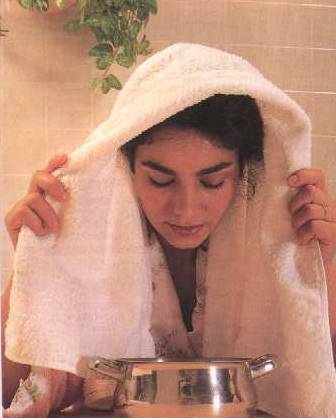
Or as our grandmother taught us ...
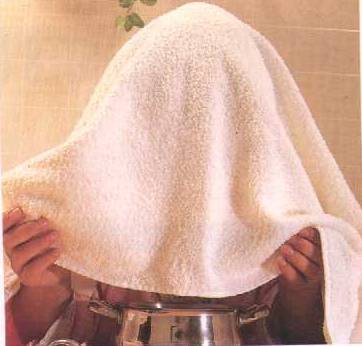
-with an aroma lamp or burner
(the water is heated with a candle where some drops of essential oils
are added)
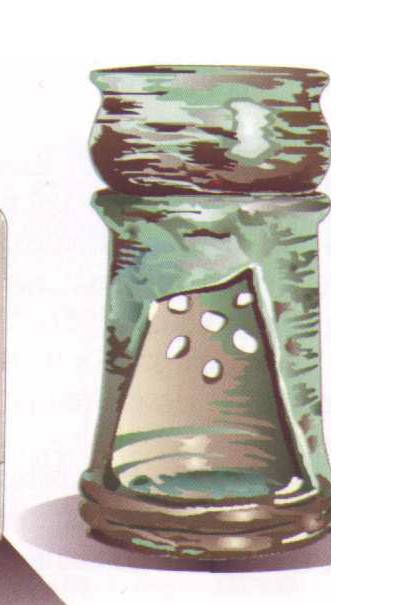
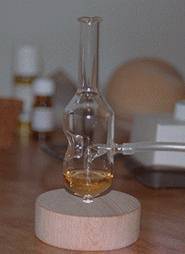
-in the bath
3.2.2 Oral use:
This is controversial - there are two opinions here:
I call them the French school of aromatherapy, which uses a lot of
essential oils orally, and the Anglosaxon school, which has banned this
method of using essential oils.
*******
For instance for me, here in Belgium where I live oral use of essential
oils is quite common.
I generally advise the use of 1-3 drops a day, limited in time (max.
3 weeks)
and only with pure essential oils that do not have toxic components.
Usually the oral use of essential oils is limited to a few hours or
days
because they work so rapidly!
Some oils are diluted with a emulgator (in Europe for instance "Disper"
or
alcohol), or dissolved in honey.
The resulting mixture is taken orally in a similar way as tinctures.
There are some commercial products on the market with a mixture of
essential oils and tinktures.
No problems are recorded for these products.
I am sometimes amazed to see the heavy discussions in the UK AND the
USA about
this topic.
I also understand that you can easily be sued in the US if you hurt
someone by dangerous or bad advice. This is less evident here in Europe.
This could IMHO explain the reluctance of most US authors to write
about oral use of essential oils.
Michel
**********************
3.2.3 Using oils "Neat"
>When someone speaks of 'neat' Lavender, Please explain what 'neat'
refers to!!
Simply "Undiluted" not mixed with anything else..
OK ??
:-)
***********
You know when you sidle up to the bar and say......"whiskey, neat"......It
means "undiluted". To apply "neat" is to apply undiluted essential
oil
directly on the skin. Be careful, only a very few oils are safe
applied
neat, most commonly lavender and tea tree. If experimenting with
others,
make sure you are aware of all the safety data.
Be well,
Marcia Elston
************
Just a caution I'm sure I've bored you all with before. I've never
had a
problem with using Lavender neat but I have seen some nasty rashes
caused by
... 'over-enthusiastic' use of tea tree. It's action may superficially
be
gentle but it's an arborescent and needs to be treated with respect.
Love and light,
Merlin.
***********
3.2.3 Dangers and toxicity of essential oils:
***************************************************
My sister mentioned that she had seen an article in the paper this
morning
where a man was hospitalized after ingesting about a half ounce of
wormwood. He bought it from an aromatherapist on the internet.
He read an
article about absinthe and stupidly drank the essential oil, thinking
it
would get him high. He's survived, but his liver and kidneys
aren't in
very good shape.
Just another reason for us to be very diligent about sending safety
data
information to any (especially new) customers (if you are in business)!
Marcia Elston
****************************************************
Back in the early 60's I saw a little girl die from spearmint oil ingestion
her mother had around for cooking. It took her days and destroyed
her
kidneys, etc. If you have ever seen such a thing, you won't think
posting a
warning about ingestion of EO's excessive.
When I teach an herb class, I always insist that the students get a
box with
a lock and key to keep EOs in. The same should apply to any medicine
chest.
Many poisonings occur with children when they are visiting
their
grandparents or relatives and friends where things are not put up.
Posting warnings and taking precautions should not be perceived as a
threat
against the "harmlessness," of EO's or herbs as opposed to allopathic
medications or treatments. Nor should it imply that they are
never used any
other way in different places and at different times. People
who know how
to use EO's internally will continue to do so with all the bells and
whistles
in place. Pharmacies do not dispense (in this country, USA),
many remedies
without prescriptions and complete printouts of warnings, because (among
other things), it is just human nature to abuse them. Why
should we do
less?
Traiteusse@aol.com
****************************************************
First off, it is not an absolute thing. Things are not "toxic"
or
"non-toxic" the way someone is "pregnant" or "not pregnant"!!!
It is
dependent on dose and the person receiving the dose.
Everything is toxic if one receives enough of it internally. Some
things
are toxic with just a little. Some make one a little sick with
a small
dose, and sicker with a larger dose. Sometimes the dose larger
enough to
kill someone is really so large that it is hard to imagine one getting
that
much and people seldom do. Other times, it takes only a microscopic
amount
to kill. Most substances of this sort are not available to the
general
public in most countries. Other substances are available which
can
certainly kill in doses that are also available. Some of these
are
medicines, some are household cleansers, some are pesticides, some
are
chemicals used in photography or antique restoration or offices or
whatever
else you can think of. They will remain on the market because
they have
uses and most people have sense enough to keep them away from children
and
not to drink them themselves. There is no more reason to take
these off the
market or restrict their sale than there is with kitchen knives, which
can
certainly also be weapons of death.
There are measurements of how much of some chemical it takes to kill
and
these were usually derived by killing a lab mouse (or some animal)
with the
substance in question, and some source somewhere will include most
any
chemical you can name. This amount is usually stated in "amount
of
substance" (in grams) per kg of weight of subject ingesting it.
Obviously
heavier people need more. There are other variables however and
these are
not always things which have been or could be measured. Some
people may be
allergic and overreact and therefore need much less. Differing
metabolisms
may treat a substance differently. And human metabolism changes
with age.
Also men are different from women. Various illnesses may change
things, and
certainly medications may interact and make the toxicity greater or
less.
There are lots of variables.
There is also dermal toxicity, the amount that needs to be on the skin
for
adverse effects. More detail is known of this with EOs probably
than of the
internal use. This is because cosmetics companies have studied
EOs and
their component ingredients extensively. Martin Watt's books
contain good
charts and info on both oral and dermal toxicity. Check
with Sylla for info
on these or email
your question and snail mail address to SyllaH@aol.com
There is also a book by Robert Tisserand which
has been mentioned. One difference with these two is that Tisserand
is
likely to state that something is not toxic if it has been in use for
a long
time or if no studies have been done. Watt is likely to say that
caution is
important because no studies have been done. For particular chemicals
there
is also a toxicity database connected to the USDA Phytochemical database,
accessible on the web at www.pl.barc.usda.gov
As a rule of thumb, 1-3 drops once to thrice daily for a limited period
of
time (less than two weeks) of most most EOs should not be a problem
for an
adult who is not pregnant or taking regular medication which could
interact,
or does not have allergies or asthma. If any adverse effect is
noticed,
STOP taking the EO. If the desired effect is achieved, stop taking
the EO
when you no longer need it. Be prudent, cautious, read up on
the EO in
question and be sure you have good quality stuff before you put anything
in
your mouth. And don't take it for amusement! These are
powerful chemicals.
-------Jo
**********************************************************
…… there is a lot of dispute about which oils are "safe"
and which ones aren't,
and this varies from country to country as well as between different
authors.
My head was going round in circles when trying to find out about
toxicity of
some of the oils that seem to be good for lice, and also for birch
EOs. And
then there's the pennyroyal oil debate, which Martin Watt said he wrote
about last year in Aromatic Thymes. And the book on EO safety by Tisserand
and Balacs lists some oils as safe which others don't (no, don't ask
me
which ones - I don't have the book in my possession). I strongly suspect
that the information isn't always known, so people extrapolate or use
info
from other people's books.
………
On availability of the more toxic EOs: I know that some companies won't
sell the more toxic oils to the general public, though again I think
that
that varies between countries. I think that some oils are available
in
Iceland that are not sold to the general public by the same company
in the
UK. And I remember seeing some oils, such as aniseed, for sale in a
UK shop
which I felt should not have been for sale (and I don't remember seeing
any
particular warning with these oils). I feel that the more toxic oils
should
only be dispensed if a safety warning/ usage guidelines are given with
them.
Hope this makes sense.
Lowana
***************************************************************
Unwanted effects with essential oils are possible:
Dermal toxicity
Skin irritation
Mustard oil (Brassica nogra)
Horseradish oil (Amoracia rusticana)
Mucous membrane irritation
Phototoxicity, photosensitivity
Some essential oils known to have this undesired effect:
Angelica root (Angelica archangelica)
Bergamot, expressed (Citrus bergamia)
Dill, weed (Anethum graveolens)
Lime, expressed (Citrus medica)
Mandarin (Citrus reticulata)
Orange, expressed (Citrus sinensis)
Patchouli (Pogostemon cablin)
Rue (Ruta graveolens)
Verbena (Lippia citriodora)
Sensitizing oils: (most important ones)
Alant root (Inula helenium)
Calamus
Cassia
Cinnamon bark and leaves
Colophony resin
Costus root
Peru balsam
Cross-sensitization
x means cross reactions may occur
Colophony resin x Peru balsam x Benzoin x Turpentine
x Peppermint.
Bay costus x Costus root x Cinnamon bark
Prolonged use
I can easily confirm that every essential oil, used day after day,
month after month will have negative effects
one day.
With external and specially oral use the oils should be changed reglulary.
Carcinogenicity
Suspected essential oils:
Camphor oil, yellow and brown (Cinnamomum camphora)
Sassafras oil (Sassafras albidum)
Brazilian sassafras oil (Ocotea cymbarum)
Calamus oil (Acorus calamus)
Neurotoxicity
Particular care must be exercised with Petroselinum sativum (fruct),
Peumus boldus, Thuya (Thuya occidentalis), Sage (Salvia
officinalis)-except the low thuyone(thujone) sage
from the French Drome region and also Lavandula lavendulaefolia, Tanacetum
vulgare, Artemisia vulgaris, Artemisia absinthium and Calamus (Acorus calamus).
Hepatotoxicity
-Thuyone, thymol and turpentine oil may dammage the liver following
oral ingestion
in high doses.
Nephrotoxicity
Excessive use of some oils can be toxic to the kidneys:
-Juniperus sabina
-Birch oil (Betula lenta)
-Wintergreen (Gaultheria procumbens)
-Sassafras (Sassafras albidum)
-Sandalwood (Santalum album)
-Turpentine
Respiratory sensitivity
Some asthma patients can react in a negative way to different essential
oils, during or after a massage or even with the use of a nebulizer.
It is very difficult to establish a list of these oils, due to individual
sensitivity.
I have very good results with these people with the use of Hyssop (Hyssop
montana canescens (ex decumbens) in nebulizers, either alone or in a synergy
with other essential oils.
Useful literature:
-Plant Aromatics - Martin Watt
-The Aromatherapy Practionner Reference Manua l- Sylla Sheppard-Hanger
-Aromatherapy for Health Professionals - Shirley Price/ Len Price
-A Safety Guide on the Use of Essential Oils - -
The International School of Aromatherapy
-L'aromathérapie Exactement - P. Franchomme, Docteur Pénoel
…………..
*****************************
3.3 Aromatherapy science
3.3.1 How old is aromatherapy?
It is commonly believed that "modern aromatherapy" was "rediscoverd"
by
Gattefosse in the 1920s.
The medical use of essential oils is much older however.
3.3.2 About essential
oils
An essential oil is a volatile material, derived by a physical process
from
odorous plant material of a single botanical form and species with
which it agrees in name and odor...In exceptional cases, the essential
oil may be formed during processing when plant tissue is brought into contact
with water. A few eo's represent volatile products formed during destructive
distillation of the natural raw material.
Certain botanical species are scarcely odorous at all, yet they produce
essential oils when distilled subsequent to maceration. The maceration
may start off a fermentation or an enzymatic process, neither of which
are physical processes. See Almond Oil, Bitter, and Wintergreen Oil.
Essential Oils are either distilled or expressed. Distillation can
be,
Water Distillation
Steam Distillation
Water-and-Steam Distillation
or
Dry Distillation
(From the book of Arctander)
***********
Essential oils are found in plants:
Flowers
-------
Ex: Neroli, Rose, Marjoram...
Roots:
------
Ex: Valerian, Nard, Angelica...
Leaves/needles:
---------------
Ex: Pine, Eucalyptus, Cypress...
Resins
------
Ex: Frankincense, Turpentine...
Seeds
------
Ex: Anise, Fennel, Dill...
Fruits
------
Ex: Citrus fruit (Lemon, Orange...)
Berries
-------
Ex: Cloves
Bark
----
Ex: Cinnamon, Sassafras...
...
Wood:
-----
Sandalwood, Cedar, Rosewood...
They have been under analysis for a long time. Currently, many (but
not all) chemical components of essential oils
are known (terpenes, esters, coumarins, alcohols, phenols ...).
3.4 Production of essential oils.
3.4.1 Enfleurage:
Historically probably the first method used to obtain the aroma
of plants. Used for very delicate petals. The petals are placed on
fat
in layers. The essential oils are transferred from the petals to the
fat. Then the fat has to be removed by solvents e.g. hexane. Then the
solvent is removed by Rectification and further processes redissolve
the
oils in alcohol. This process gives what is called an Absolute. This
is
a very labour and time consuming way of obtaining the essential oil.
hence absolutes are usually quite expensive.
Following are some images from the Fragonnard perfume museum, Grasse, taken in March 1998:
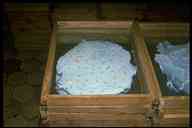
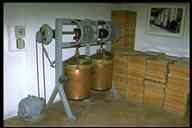
3.4.2 Distillation (steam):
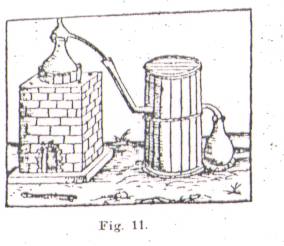
Go to Michel Vanhove's distillation images page : detailed images of wild lavender distillation.
(note: page under construction-12-6-2012)
Co-distillation?
****************
I've found at least two processes called
by this name:
- putting two different plants or plant parts in the still and
steaming them together to produce one oil;
- adding an essential oil to plant material and distilling them
together, again producing one oil.
*********
The main reason why codistillation is done is the fact that some plants
contain only a very small amount of essential oils, for instance:
-Robinia pseudacacia (Acacia): circulation
-Crataegus oxyacantha (Hawthorn) heart circulation, nervous system
-Tillia sylvestris (Linden tree) kidney drainage, purifier
-Melilotus officinalis (Field melilot) circulation, veins
-Melissa officinalis (Melissa) cramps, nervous system
-Spirea ulmaria (Meadowsweet) kidney, joints
The price of these oils would be prohibitive to most consumers, those
oils
would only be accessible to rich people. For instance Melissa
officinalis yields only 0.014 % EO! This is about 1 liter for
7
ton of Melissa! The yield of Melissa is still high compared with
Tilia sylvestris and Acacia decurrens (Mimosa).
These oils are often extracted with solvents, to provide a higher
yield, but this rules them out for medical use.
So some distillers in France (and probably also in other countries)
produce these oils by codistillation.
Two methods are possible: the distillation of two botanically
different plants, or adding essential oils together with the plant
during distillation.
The product obtained will have similar medical actions to the pure
essential oil. Here the experience and knowledge of the distiller
is
very important: the choice of synergy is not an easy one.
Usually the essential oils obtained by this method have a label indicating
the production method used, either explicit or in a code.
This information is from "Huiles essentielles - Hydrolats"
by Henri
Viaud, Edition Presence. 1983. France
3.4.3 Hydraulic pressure (citrus oils):
Expression
Expression is used only
for the oils in the peels of citrus
fruits. It involves pressing the outer layers of the peel mechanically.
The oils are then collected. For theraputic oils, it is best that the
oils have been "Cold Pressed". This keeps the properties of the oils
constant compared to the methods where heat is also used to obtain
more
oil from the peel.
3.4.4 CO2 extraction method:
CO2 Extraction
A relatively new method of extracting essential oils,
particularly for the food industry. The theraputic properties of these
oils are still being assesed. CO2 extracted oils are said to resemble
those of solvent extracted oils (absolutes).
**********
Susan, here are two references to CO2.
Penoel & Franchomme:
It is one of the most modern methods of extraction, but also
the most expensive. It consist of passing a current of CO2 through the
vegetable mass, which, by increasing the pressure, bursts the pouches of
essence and carries off the aromatic substances. Diverse studies tend to
prove that this process respects integrally the original essence.
Shirley Price:
The technology calls for very expensive equipement, (millions of pounds
worth),
which uses carbon dioxide at very high pressures and extremely low
temperatures. With this method, more top notes, fewer terpenes, a higher
proportion of esters, plus larger molecules, are obtained. The resultant
oil is said to be more like the essential oil in the plant, as many terpenes
in a distilled oil seem to form during the distillation process, which
also breaks down some of the acetates (esters) in the plant material.
CO2 extracted essential oils are pure and stable, colorless and have
no residue
of CO2 left in them - they should be excellent theraputically, although
this needs to be verified for each oil on account of their different compositions.
At the moment the price is high; perhaps after a number of years, when
the equipment has paid for itself...the prices will be lower.
This method is not suitable for all oils; there are still a few practical
difficulties to overcome (sometimes an emulsion is produced), but I
am tempted to try them!
Hannibal
3.4.5 Extraction with solvents:
This method was first applied to flowers in 1835 by Robiquet.
(J.Pharm. 21 (1835), 335. Buchner's Repert. f.d.Pharm.54 (1835),
249.
Pharm. Zentralbl. (1835), 553. )
The principle of extraction with volatile solvents is simple: fresh
flowers are charged into specially constructed extractors and extracted
systematically at room temperature, with a carefully purified solvent...
The solvent penetrates the flowers and dissolves the natural flower
perfume together with some waxes and albuminous and coloring matter. The
solution is subsequently pumped into an evaporator and concentrated at
a low temperature. After the solvent is completely driven off in vacuo,
the concentrated flower oil is obtained.
Thus the temperature applied during the entire process is kept at
a minimum; live steam, as in the case of distillation, does not excert
its action upon the delicate constituents of the flower oils.
Compared with distilled oils the extracted flower oils, therefore,
more truly represent the natural perfume as originally present in the flowers.
Despite this obvious advantage the volatile solvent process cannot
entirely replace steam distillation, which remains the principal method
of isolating essential oils. Steam distillation, in most cases, is a simpler
process: by employing portable direct fire stills, distillation can be
carried out even in remote and primitive parts of the world, whereas solvent
extraction necessitates complicated and expensive apparatus, and a crew
of well trained workers.
Guenther, Volume I, page 200
It's good to mention that in modern, medicinal-orientated French aromatherapy the use of solvent extracted oils is not permitted: the possible residues of the used solvents are contra-indicated for oral use.
French sources state that they have found in the past residues of 6
percent and sometimes
even up to 25 percent of the used solvents!
They cite the work of Y.R. Naves (Editions Masson) showing the extreme
toxicity of solvents,
all affecting the central nervous system:
Technologie et chimie des parfums naturels" YR Naves-Ed.
Masson 1974
We should also not forget that solvent extraction will create another
essential oil as to the one
obtained with steam distillation and other properties will also be
present.
Distiller Henri Viaud writes that for instance steam distillation of
Eugenia caryophyllata gives an
essential oil with 70-90 percent of eugenol, and also 5-12 percent
beta-caryophylene, but the latter is not found
in the oil obtained with solvent (benzene) extraction!
The same problem is found with the Matricaria chamomilla, where only
steam distillation is able
to create the "genuine", blue colored essential oil.
Henri Viaud-editions Présence, 1983-ISBN 2-901696-33-3)-
Concretes:
...Concretes are prepared from non-resinous or low resinous raw
materials...Jasmin is a typical and well-known concrete...The most
frequently used solvents are: petroleum ether, benzene, gasoline, butane,
or, in certain cases, acetone, methylene, dichloride, trichloroethylene
and other solvents which are not exactly hydrocarbons. Non-volatile solvents
are occasionally used: diethylphthalate, benzyl benzoate, diethyl sebacate,
isopropyl myristate, etc
Absolutes:
Absolutes are highly concentrated, entirely alcohol soluble and usually
liquid
perfume material. They are obtained by alcohol - extraction of concretes
or other
hydrocarbon types of extracts or from fat-extracts of plant material.
Waxes, terpenes, sesquiterpenes and most of the odorless matters are eliminated
from concretes during the preparation of absolutes.
(From the book of Arctander)
Some of the essential oils commonly obtained by solvent extraction:
Beeswax
Calendula officinalis (Marigold)
Cloves (Eugenia caryophyllata) (sometimes)
Costus
Gardenia
Geranium ((sometimes)
Hay
Heliotropus
Humulus lupus
Hyacinth
Jasmin
Labdanum
Lavandin (sometimes)
Lilac
Melilotus officinalis
Mimosa
Moshus
Musk
Myrrh (sometimes)
Orris
Osmanthus
Reseda
Rose (sometimes)
Tagetes( sometimes)
Tobacco
Tolu balsam (sometimess)
Tonka bean
Tuberose
Viscum album
...
*************
End of part I
**************